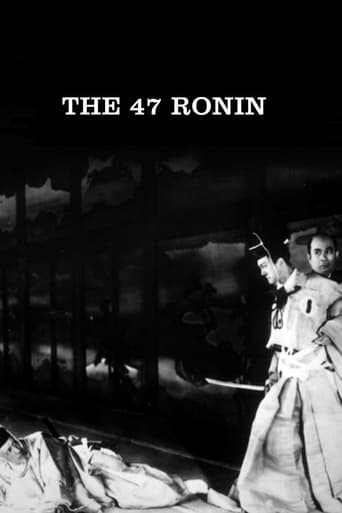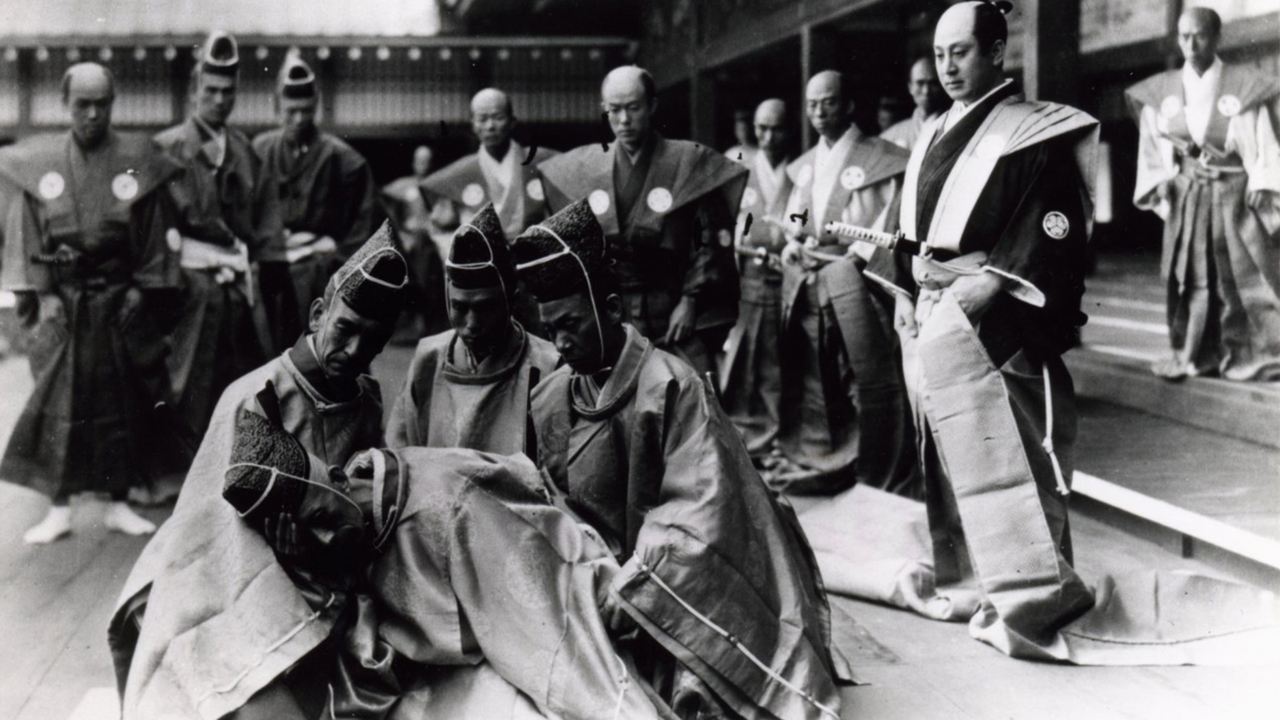WILLIAM FLANIGAN
PART 1 (Zenpen). Viewed on Streaming. Costumes = nine (9) stars; cinematography = eight (8) stars; set location/design = eight (8) stars; score = seven (7) stars; subtitles = five (5) stars; restoration = three (3) stars. Director Kenji Mizoguchi's prodding version of an old, well-known fictionalized tale (set at the turn of the 18th Century) with propaganda potential (it was endorsed/supported by the government) held to a minimum. Mizoguchi seems to never stray far from his original source material (a stage play) with dialog designed more for live theater than a movie. The Director has his actors/actresses deliver mostly mini soliloquies and expository information instead of using his camera to show events being described (sort of "no show and tell"!). Many (unseen) events are repeatedly described and trivial lines picture in words what the camera is simultaneously showing as if contemporary audience were considered to be very slow on the uptake. Mizoguchi deploys a huge cast that conveys the sheer magnitude of the bureaucracy then ruling the country. Costumes are outstanding (too bad the film was not shot in color!). Cinematography is very good with some especially creative overhead tracking shots. Sets are spectacular (exteriors are shot using Kyoto area landmarks). Restoration is not there yet. Visual artifacts are present throughout the film, and sound deterioration is a frequent irritation. Score (performed by a small-sounding orchestra) is way above what was the contemporary norm. It is creative and supports/enhances scenes. Subtitles are okay.PART 2 (Kouhen). Viewed on Streaming. Costumes = eight (8) stars; cinematography = five (5) stars; restoration = two (2) stars. Director Kenji Mizoguchi continues his less than engaging all-talk-and-no-action adaption of a movie from a play. The two major events (i.e., the assassination of the Shogun (Japan's military ruler) and Seppuku (ritual suicide) committed by the assassin as punishment) occurs off screen, but are endlessly talked about on screen. Budgeting constraints become obvious with some exterior scenes reused from Part 1 and very few new exterior scenes provided. (Even the Ronin count is down to 46!) Since the outcome of this folk tale is well known, Mizoguchi stretches his film between the Shogun's assassination and carrying out the penalty the assassins must pay (according to the law) by inserting endless pseudo philosophical discussions plus a silly, off-the-wall romantic subplot (or two) of no consequence. The film could easily be cut at least in half starting with the elimination of Part 2 and folding its two significant events into Part 1 (which has room to spare!). It remains a mystery how an open-secret plan to kill off the Shogun could not be rendered moot by either a preemptive strike on the rebels by the Shogun's huge army or at least deploying troops to totally protect the Shogun from harm! But, of course, this is all make believe. (Recent historical research suggests that the death of this group of Ronins may have occurred in battle and not by Seppuku.) Restoration seems to be limited to just splicing (poorly) reels together. Keep caffeine pills at the ready when viewing! WILLIAM FLANIGAN, PhD.
rickrudge
The 47 Ronin (aka) The Loyal 47 Ronin of the Genroku Era (1941)If you're at all familiar with the Samurai genre, you have no doubt heard of the legend of the 47 ronin. This was an actual Japanese historic event that everyone in Japan knows about. This was reenacted in 1962 (47 Samurai) 1994 (47 Ronin) and just recently in 2013 with Keanu Reeves.If you haven't heard the story, Lord Naganori Asano (Yoshizaburo Arashi) is scolded by Lord Yoshinaka Kira, the Shogun's Chief of Protocol, and in a fit of anger, draws his sword and attacks Lord Kira in a wing of the Shogun's palace. Lord Asano is immediately ordered to commit harakiri and all of his property and possessions are confiscated. The injured Lord Kira (who is related to the Shogun) is not punished at all. Lord Asano's Senior Counselor, Kuranosuke Oishi (Chojuro Kawarasaki) is helping with the tally of the possessions of Ako castle. The now masterless Samurai are biting at the bit to take immediate vengeance on Lord Kira, but Oishi asks them to be patient and has been petitioning the Shogun to offer equal justice. Vengeance would be coming later when the safety of Lord Asano's wife would be guaranteed and finally an honorable death. This particular film was made in 1941, so you know this was meant to encourage patriotic fervor, very similar to the propaganda war movies here in the United States. In fact, at the beginning each of the two part movies, there is the sentence, "Defend the homes of those who fight for a greater Asia." You would almost expect the film to have been destroyed by the American occupation censors. Perhaps they couldn't get past the four and a quarter butt-numbing hours of the film's length.One thing that is missing from this film that we would normally expect from a samurai film is that there is no blood or any show of swordsmanship skills at all. It's strictly a historic costume drama.
Claudio Carvalho
In 1701, Lord Takuminokami Asano (Yoshizaburo Arashi) has a feud with Lord Kira and he tries to kill Kira in the corridors of the Shogun's palace. The Shogun sentences Lord Asano to commit suppuku and deprives the palace and lands from his clan, but does not punish Lod Kira. Lord Asano's vassals leave the land and his samurais become ronin and want to seek revenge against the dishonor of their Lord. But their leader Kuranosuke Oishi (Chôjûrô Kawarasaki) asks the Shogun to restore the Asano clan with his brother Daigaku Asano. One year later, the Shogun refuses his request and Oishi and forty-six ronin revenge their Lord."Genroku Chûshingura" is a Japanese classic movie based on a true story. Kenji Mizoguchi made a too long movie with four hours running time that is actually a slow-paced immersion in an ancient and different culture and code of honor. Unfortunately this beautiful movie is only for very specific Western audiences since it is in Japanese language, shows a different culture, most of the characters are alike (clothing, haircut, biotype) and unusual names that you need to keep in mind. But the movie is worthwhile watching and delights fans of this genre. My vote is seven.Title (Brazil): "A Vingança dos 47 Ronins" ("The Revenge of the 47 Ronin")
EdwardVI
"The 47 Ronin" is a pathetic account of a real japanese event, that took place around 1780. 47 Samurai warriors were forced to commit Seppuku, ( ritual suicide by perforating your own stomach ) after they avenge their master's humiliation and eventual death.While watching the film, you are compelled to cry and pray for the admirable bravery, loyalty and humility of the Ronin (Masterless Warriors). Who besides their war skills, are profound philosophers and compassionate men.The most inspiring film in my life.


 AD
AD



